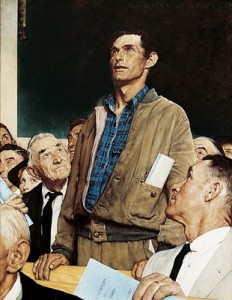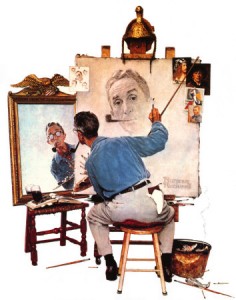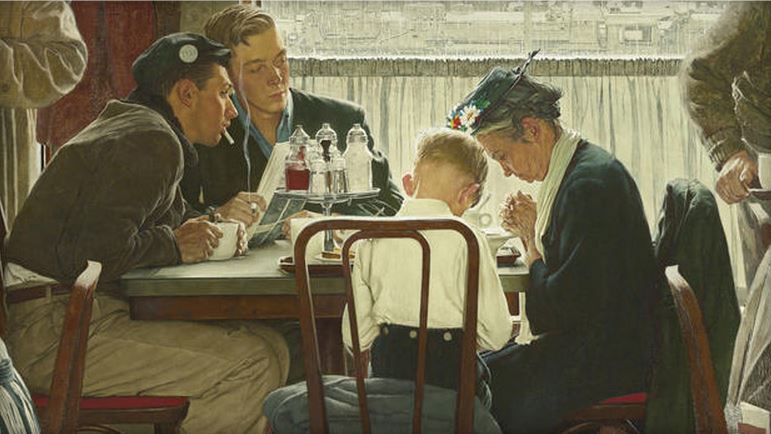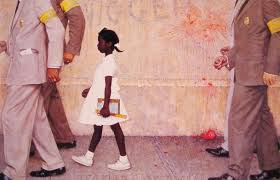Today one of Norman Rockwell’s best loved paintings, Saying Grace, sold in auction for a record $145 million.
Until today, the highest price ever paid for an American painting was $27.7 million, the 1999 selling price for George Bellows’ “Polo Crowd”. Rockwell’s own previous auction record was $15.4 million for “Breaking Home Ties”, which sold in 2006.
Saying Grace was first published as the cover art on the Saturday Evening Post on November 24, 1951. It was characteristic of Rockwell’s works: complex, layered with details which only gradually reveal their story—like the umbrellas and grey-streaked window which hint at a dreary rain, and the other customers standing in the crowded restaurant, lending a sense of movement.
But more than that, Rockwell’s paintings are rife with meaning.
 Look closely at Freedom of Speech, one of Rockwell’s Four Freedoms paintings which were based on President Franklin D. Roosevelt’s 1941 State of the Union address. The man’s ear—isn’t it abnormally large? It is, and it’s through this small detail that Rockwell conveys his appeciation for the rights accorded in America, in this case the right to speak freely in the public forum.
Look closely at Freedom of Speech, one of Rockwell’s Four Freedoms paintings which were based on President Franklin D. Roosevelt’s 1941 State of the Union address. The man’s ear—isn’t it abnormally large? It is, and it’s through this small detail that Rockwell conveys his appeciation for the rights accorded in America, in this case the right to speak freely in the public forum.
- In The Problem We All Live With, Rockwell addressed Southerners’ attitude toward race which was prevalent in 1960, when racial integration was mandated by federal law. In the true-to-life painting, six-year-old Ruby Bridges, an African-American, is escorted to an all-white school in Louisiana, her safety assured by four U.S. Deputy Marshals who accompany her through the line of taunting whites. The segregationist crowd has thrown ripe tomatoes, and the wall and sidewalk are smeared with the ripe fruit. Rockwell, it’s said, was troubled by the scene—so much so that he softened it with a little romance, painting his and his wife’s initials etched into the concrete wall.
 In Rockwell’s Self-Portrait, he adds a touch of self-effacing humor. On a trip to Europe, Rockwell had hoped to find a historical treasure; so when he encountered a vendor selling what appeared to be an original centurion’s helmet, he was excited by his find. Only later did he learn that his prize was actually a cheap tourist souvenir, not a priceless artifact. Rockwell kept the helmet on his easel as a reminder, lest he ever take himself too seriously; and there it remains to this day in his Stockbridge studio.
In Rockwell’s Self-Portrait, he adds a touch of self-effacing humor. On a trip to Europe, Rockwell had hoped to find a historical treasure; so when he encountered a vendor selling what appeared to be an original centurion’s helmet, he was excited by his find. Only later did he learn that his prize was actually a cheap tourist souvenir, not a priceless artifact. Rockwell kept the helmet on his easel as a reminder, lest he ever take himself too seriously; and there it remains to this day in his Stockbridge studio.
Saying Grace is one of Rockwell’s best loved works. The winsome grandmother with her young grandson, heads bowed in simple prayer, are in sharp contrast with the hardened youths who share their table; but the young men, who perhaps have never seen such an unabashed expression of devotion, are not offended. Rather, the youths seem curious, attracted to these people, the grandmother and the child, whose staunch hometown values include a strong faith lived with assurance. If this is the young men’s first encounter with Christians, one hopes that they meet others who can further confound them, touching their hearts and stirring in them the desire to know more.
In The Everlasting Man, G.K. Chesterton wrote that “a young man who is serious about his atheism cannot be too careful about what he reads.” One might add, he cannot be too careful about with whom he sits at dinner.













